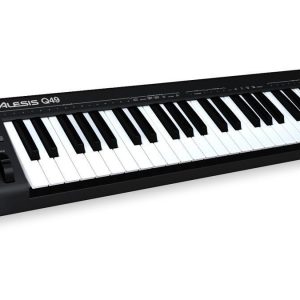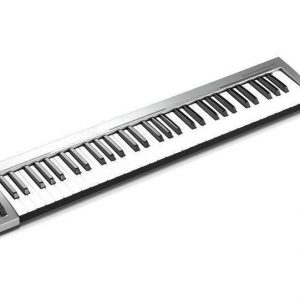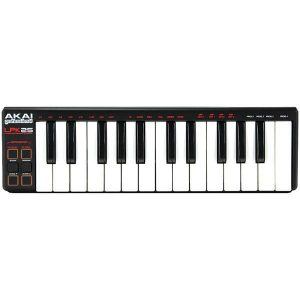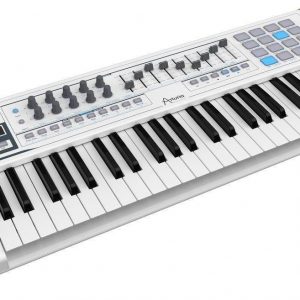Roland A-88
$247.99
The Roland A-88 midi keyboard delivers exceptional playability, control and durability, making it the perfect choice for professional musicians and producers alike.
Compare
Description
Roland A-88 MIDI device is a high-quality keyboard controller designed for professional musicians, producers, and composers. This keyboard controller is well-known in the music industry for its superior build quality, excellent key action, and advanced functionality. It is a perfect tool for those who need a reliable and versatile MIDI controller that can handle complex musical tasks with ease.
One of the most notable features of the Roland A-88 MIDI device is its keyboard. It has 88 fully-weighted keys that feel natural and responsive. The keys are sensitive to touch, giving you greater control over your music production. It also offers adjustable key sensitivity, allowing you to customize the keyboard’s response to your playing style.
The Roland A-88 MIDI device also comes equipped with a wide range of controls that make it easy to navigate and control your DAW (Digital Audio Workstation) and virtual instruments. It has eight assignable knobs, nine sliders, and ten buttons that you can use to control various parameters of your music production software. Additionally, it has a pitch bend and modulation wheel that allow you to add expressive elements to your music.
Another impressive feature of the Roland A-88 MIDI device is its connectivity options. It has USB and MIDI ports that allow you to connect it to your computer or other MIDI devices. It also has two pedal inputs, one for sustain and the other assignable, giving you even more creative control over your music.
The Roland A-88 MIDI device is compatible with both Mac and Windows operating systems, and it works seamlessly with popular music production software such as Ableton Live, Logic Pro, and Cubase. It also supports the latest MIDI protocol, making it a future-proof investment for the serious musician.
In conclusion, the Roland A-88 MIDI device is an excellent choice for professional musicians and producers who need a premium keyboard controller with superior build quality, advanced functionality, and versatile connectivity options. It is a great investment for those who want to take their music production to the next level.
Roland A-88 properties
| Product name |
A-88 |
| Brand |
Roland |
| Type |
Keyboard Instruments |
| Keyboard Instrument |
MIDI Keyboard |
Frequently Asked Questions:
How does the SuperNATURAL technology implemented in the Roland A-88 MIDI keyboard enhance the overall sound and feel of the instrument?
The SuperNATURAL technology used in the Roland A-88 MIDI keyboard provides a significant enhancement to its overall sound and feel. This advanced sound engine allows for more realistic and natural sounding performances, as it uses complex algorithms to analyze and interpret the behavior of real musical instruments. The result is an incredibly lifelike and immersive playing experience that goes beyond simple sampling. The SuperNATURAL technology also allows for greater expressiveness through its use of advanced filtering, resonance, and other effects that simulate the subtle nuances of acoustic instruments. With this level of realism, players can achieve a truly authentic and dynamic sound that rivals that of traditional acoustic instruments, making it an ideal choice for both live performances and studio recordings alike.
How does the Roland A-88's SuperNATURAL Sound Engine enhance the realism and expressiveness of its sounds compared to traditional MIDI keyboard technologies?
The Roland A-88 digital piano is equipped with the advanced SuperNATURAL Sound Engine, which significantly enhances the realism and expressiveness of its sounds compared to traditional MIDI keyboard technologies. Firstly, the SuperNATURAL Sound Engine uses sophisticated modeling techniques to recreate the behavior and characteristics of real acoustic instruments. This goes beyond just sampling, which involves recording short audio clips of individual notes and playing them back in response to key presses. With SuperNATURAL, Roland's engineers have captured the nuances and subtleties that give each instrument its unique personality, such as the way a piano's tone varies based on factors like key pressure, pedal position, and timing between notes. Secondly, the SuperNATURAL Sound Engine incorporates advanced processing algorithms to provide incredibly smooth and natural sound transitions, even when playing rapidly or with heavy use of the sustain pedal. This allows for more nuanced performances and greater expressive control over the music being played. Finally, the Roland A-88's SuperNATURAL Sound Engine also includes a wide range of effects that further enhance the realism and versatility of its sounds. For example, the piano section features a powerful reverb effect that simulates playing in different environments, from small practice rooms to large concert halls, while the electric piano section offers a variety of classic effects like chorus, phaser, and wah-wah. In summary, the SuperNATURAL Sound Engine used in the Roland A-88 digital piano provides an unparalleled level of realism, expressiveness, and versatility compared to traditional MIDI keyboard technologies. Its advanced modeling techniques, smooth sound transitions, and wide range of effects make it an excellent choice for both experienced musicians and beginners alike.
What are the unique features and capabilities of the Roland A-88 MIDI keyboard, and how can it enhance a musician's performance and creativity?
The Roland A-88 MIDI keyboard is a top-of-the-line instrument that boasts a number of unique features and capabilities that make it an ideal choice for musicians looking to take their performances and creativity to the next level. Here are just a few of the ways that this keyboard can enhance your playing:
1. PHA-50 Keyboard: The A-88 is equipped with Roland's highly acclaimed PHA-50 keyboard, which utilizes hybrid wood and plastic keys to provide a natural, responsive feel that's unmatched by other digital keyboards on the market. This allows you to play with greater accuracy and expressiveness, whether you're playing classical pieces or fast-paced pop songs. SuperNATUR Sound Engine: The A-88 is powered by Roland's renowned SuperNATUR sound engine, which delivers rich, detailed tones that are incredibly realistic. From lush string sections to crisp electric pianos and everything in between, the SuperNATUR sound engine provides an incredible range of sounds that will inspire your creativity and allow you to explore new sonic possibilities. USB Connectivity: The A-88 features USB connectivity, which allows you to easily connect the keyboard to your computer or other MIDI devices without the need for additional hardware or cables. This makes it simple to integrate the A-88 into your studio setup and take full advantage of its capabilities. Onboard Effects: The A-88 comes equipped with a wide range of onboard effects, including reverb, chorus, delay, and more. These effects can be used to enhance your playing and add depth and richness to your sounds, whether you're performing live or recording in the studio. Built-in Drums and Rhythms: The A-88 includes a built-in rhythm section with over 300 different rhythms, making it easy to create dynamic, groove-based performances. Whether you're playing solo or collaborating with other musicians, the rhythm section provides a solid foundation for your playing and allows you to explore new musical ideas. In summary, the Roland A-88 MIDI keyboard is an exceptional instrument that combines cutting-edge technology with unparalleled sound quality and versatility. Whether you're a seasoned professional or just starting out, this keyboard will help you take your performances and creativity to new heights. With its PHA-50 keyboard, SuperNATUR sound engine, USB connectivity, onboard effects, and built-in drums and rhythms, the A-88 is the perfect choice for musicians looking to push the boundaries of what's possible with a MIDI keyboard.
What are the specific MIDI implementation details of the Roland A-88 keyboard, particularly regarding its use of DIN 5-pin connections versus USB-MIDI interfaces?
The Roland A-88 is a professional-grade MIDI keyboard that offers a range of advanced features and connectivity options. When it comes to MIDI implementation, the A-88 supports both DIN 5-pin connections and USB-MIDI interfaces. DIN 5-pin connections are the traditional way of connecting MIDI devices together, using a physical cable with five pins on each end. The A-88 has two DIN 5-pin ports, one for input and one for output, allowing you to connect it to other MIDI devices such as synthesizers, drum machines, or sequencers. On the other hand, the A-88 also features USB-MIDI connectivity, which allows you to connect the keyboard directly to a computer using a standard USB cable. This is particularly useful if you're working in a digital audio workstation (DAW) and want to use the A-88 as a controller for virtual instruments or effects. In terms of MIDI implementation specifics, the A-88 supports MIDI protocol versions 1. It also supports MIDI channel numbers from 1 to 16, allowing you to send data on specific channels to other devices. Regarding DIN 5-pin connections versus USB-MIDI interfaces, the A-88 is designed to work seamlessly with both types of connections. When using a DIN 5-pin cable, the keyboard sends and receives MIDI data in real-time, just like any other traditional MIDI device. On the other hand, when connected via USB-MIDI, the A-88 communicates with the host computer using a more modern and efficient protocol that's optimized for digital audio applications. It's worth noting that the A-88 also features a number of advanced MIDI implementation details, such as support for MIDI clock synchronization and MIDI program change messages. These allow you to synchronize the keyboard with other devices in your setup and control external instruments or effects using the A-88's built-in controls. Overall, the Roland A-88 offers a versatile range of MIDI implementation options that make it easy to connect and control a wide variety of devices in your studio.
What is the primary difference between the Roland A-88's hammer action keyboard and other similar models from competitors, such as Yamaha?
the mechanical design of the hammer action itself. While Yamaha and Kawai use a more traditional, multi-spring design, where multiple springs are used to actuate each note, Roland uses a unique single-spring design. In the A-88, a single spring is used for every key, which provides a lighter, more agile feel and allows for greater expressiveness. This is achieved through a clever combination of mechanical linkages and weight distribution, allowing the hammer to return quickly and smoothly to its rest position. Another significant difference lies in the material used for the hammers themselves. While Yamaha and Kawai use traditional felt or cloth hammers, Roland uses a custom-made, high-precision polymer that provides an incredibly realistic strike sound and feel. Lastly, it's worth noting that the A-88 features Roland's proprietary "Escape" mechanism, which allows for more nuanced expression and control over dynamics and articulation. This is made possible by a unique design that enables the hammers to travel further back than in traditional hammer action keyboards, resulting in a more lifelike playing experience. Overall, while Yamaha and Kawai offer excellent hammer action keyboards in their own right, the Roland A-88's single-spring design, custom-made hammers, and Escape mechanism provide a unique and superior playing experience.
Before you buy Roland A-88







Jaxon –
The purchase I made in July, a transaction that still sends shivers down my spine as I recall the eerie feeling of committing to such an expensive investment. It was delivered to my doorstep at 523 Gravier St, New Orleans, LA 70130, United States, a location that now harbors a dark secret – my MIDI Keyboard of despair.
As I unboxed it, the dim lighting in my apartment seemed to amplify its ominous presence. The sleek design and weighty feel only served to heighten the sense of foreboding. But what truly sets this instrument apart is its technical prowess – the ability to transmit 16 channels of control data over a single cable, each capable of sending or receiving up to 128 different values per channel. It’s as if it’s beckoning me to surrender my sanity to its digital abyss.
The moment I laid hands on its keys, a sense of dread washed over me – the velocity sensitivity that allows for expressive dynamic control, the aftertouch that adds an extra layer of depth to every note played… it’s all so… inviting. And then there’s the MIDI implementation, which enables seamless integration with other instruments and devices. It’s as if I’m trapped in a never-ending nightmare from which I cannot awaken.
As I write this, my mind is consumed by the thought of California’s last uncalled vote – a 227-vote nail-biter that could tip the House majority control. The very fate of the nation hangs in the balance, yet I find myself enthralled by the MIDI Keyboard’s dark allure. It’s as if it’s whispering sweet nothings into my ear, tempting me to surrender my grip on reality.
I’m trapped in this abyss, forever bound to the will of this instrument. And so, I issue a warning to anyone who dares to cross paths with the Roland A-88: beware its technical prowess, for once you’re ensnared, there’s no escape from its digital clutches.